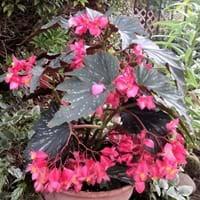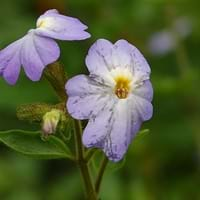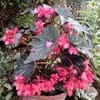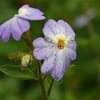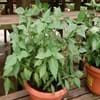Life Span
Perennial
Perennial
Type
Tender Perennial
Tender Perennial
Origin
South America, Brazil
South America
Types
Begonia grandis, Begonia obliqua
Not Available
Number of Varieties
Not Available
Habitat
Cold Regions, subtropical regions
Subtropical climates, Tropical regions
USDA Hardiness Zone
10-15
10-15
Sunset Zone
H1, H2, 23, 24
H1, H2, 17, 23, 24
Habit
Upright/Erect
Cushion/Mound-forming
Flower Color
Red, Coral
White, Blue Violet
Flower Color Modifier
Bicolor
Bicolor
Fruit Color
Tan
Not Available
Leaf Color in Spring
Green
Light Green
Leaf Color in Summer
Green
Light Green
Leaf Color in Fall
Green
Light Green
Leaf Color in Winter
Light Green
Light Green
Leaf Shape
Wing shaped
broad, flat
Plant Season
Spring, Summer, Fall, Winter
Summer, Fall
Sunlight
Full Sun, Partial Sun, Partial shade
Partial Sun, Partial shade
Type of Soil
Loam, Sand
Loam
The pH of Soil
Acidic, Neutral
Acidic, Neutral, Alkaline
Soil Drainage
Well drained
Well drained
Bloom Time
Indeterminate
Early Summer, Summer, Late Summer, Early Fall
Tolerances
Drought
Drought
Where to Plant?
Container, Ground
Container, Ground, Pot
How to Plant?
Cuttings
Seedlings, Stem Cutting
Plant Maintenance
Medium
Medium
Watering Requirements
Average Water Needs, Do Not over Water, Requires regular watering
Average Water Needs, Never Over-water
In Summer
Lots of watering
Lots of watering
In Spring
Moderate
Moderate
In Winter
Average Water
Average Water
Soil pH
Acidic, Neutral
Acidic, Neutral, Alkaline
Soil Type
Loam, Sand
Loam
Soil Drainage Capacity
Well drained
Well drained
Sun Exposure
Full Sun, Partial Sun, Partial shade
Partial Sun, Partial shade
Pruning
Pinch Tips, Pruning will encourage new growth, Remove damaged leaves, Remove dead branches, Remove dead leaves
Remove damaged leaves, Remove dead branches, Remove dead leaves
Fertilizers
fertilize in fall, fertilize in spring, High potassium diluted feed of 5-10-5
All-Purpose Liquid Fertilizer
Pests and Diseases
Red blotch
Aphids, Leaf spot, Red blotch, Whiteflies
Plant Tolerance
Drought
Drought
Flower Petal Number
Single
Single
Foliage Texture
Coarse
Medium
Foliage Sheen
Matte
Matte
Attracts
pollinators, Whiteflies, Wildlife
Aphids
Allergy
Not Available
Not Available
Aesthetic Uses
Showy Purposes
Beautification, Hanging Basket, Showy Purposes
Beauty Benefits
Not Available
Not Available
Edible Uses
Insignificant
No
Environmental Uses
Air purification
Air purification
Medicinal Uses
Conjuctivitis, Headache, Mouth Sores, Sore Eyes, Sore throat, Treatment of ulcers
Not Available
Part of Plant Used
Flowers, Leaves, Root
Flowers, Leaves
Other Uses
Container, Used for its medicinal properties
Used as Ornamental plant
Used As Indoor Plant
Yes
Yes
Used As Outdoor Plant
Yes
Yes
Garden Design
Container, Feature Plant, Houseplant, Mixed Border, Tropical
Bedding Plant, Container, Hanging Basket, Houseplant, Rock Garden / Wall
Botanical Name
BEGONIA coccinea
BROWALLIA speciosa
Common Name
Angel Wing Begonia
Amethyst Flower
In Hindi
Angel wing begonia plant
नीलम फूल
In German
Engel Flügel Begonie Pflanze
Amethyst Blume
In French
Ange aile plante bégonia
Améthyste Fleur
In Spanish
Ángel planta de begonia ala
amatista flor
In Greek
Άγγελος φυτού Begonia πτέρυγα
Αμέθυστος λουλούδι
In Portuguese
Anjo planta Begónia da asa
flor Amethyst
In Polish
Anioł skrzydło begonia roślin
Amethyst Flower
In Latin
Angelus pars plantae Begonia
Amethyst Flower
Phylum
Magnoliophyta
Magnoliophyta
Class
Magnoliopsida
Magnoliopsida
Family
Begoniaceae
Solanaceae
Clade
Angiosperms, Eudicots, Rosids
Angiosperms, Asterids, Eudicots
Tribe
Not Available
Not Available
Subfamily
Caesalpinioideae
Not Available
Number of Species
Not Available
Not Available
Season and Care of Angel Wing Begonia and Amethyst Flower
Season and care of Angel Wing Begonia and Amethyst Flower is important to know. While considering everything about Angel Wing Begonia and Amethyst Flower Care, growing season is an essential factor. Angel Wing Begonia season is Spring, Summer, Fall and Winter and Amethyst Flower season is Spring, Summer, Fall and Winter. The type of soil for Angel Wing Begonia is Loam, Sand and for Amethyst Flower is Loam while the PH of soil for Angel Wing Begonia is Acidic, Neutral and for Amethyst Flower is Acidic, Neutral, Alkaline.
Angel Wing Begonia and Amethyst Flower Physical Information
Angel Wing Begonia and Amethyst Flower physical information is very important for comparison. Angel Wing Begonia height is 45.72 cm and width 45.72 cm whereas Amethyst Flower height is 30.00 cm and width 20.30 cm. The color specification of Angel Wing Begonia and Amethyst Flower are as follows:
Angel Wing Begonia flower color: Red and Coral
Angel Wing Begonia leaf color: Green
Amethyst Flower flower color: White and Blue Violet
- Amethyst Flower leaf color: Light Green
Care of Angel Wing Begonia and Amethyst Flower
Care of Angel Wing Begonia and Amethyst Flower include pruning, fertilizers, watering etc. Angel Wing Begonia pruning is done Pinch Tips, Pruning will encourage new growth, Remove damaged leaves, Remove dead branches and Remove dead leaves and Amethyst Flower pruning is done Remove damaged leaves, Remove dead branches and Remove dead leaves. In summer Angel Wing Begonia needs Lots of watering and in winter, it needs Average Water. Whereas, in summer Amethyst Flower needs Lots of watering and in winter, it needs Average Water.
